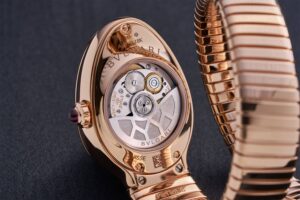Understanding Watch Servicing: More Than Just a Maintenance Task
Luxury watch owners often view their timepieces as more than just a fashion statement; they also see them as investments that appreciate over time. Regardless of whether a watch is mechanical, automatic, or quartz, ensuring its longevity through regular servicing is essential. Yet many watch owners are unclear on how often their watches should be serviced or understand the impact of skipping regular maintenance.
This article will discuss the significance of servicing a watch, give authoritative advice on how frequently to do it, and cover the potential pitfalls of allowing your watch to go for long periods without care. Unless you’re ready to let it function like an inexpensive, battery-powered timepiece (which, to be honest, is what some “luxury” watches are functionally and aesthetically after servicing if you don’t pay for high-end restoration), servicing your watch is practically an annual (or biennial or triennial) rite.
The Mechanics of Watch Servicing: What Does It Involve?
Servicing a watch is a meticulous undertaking compared to maintaining something like a car. It is done to keep your timepiece running smoothly and to ensure it continues functioning with the same precision it had when new. The watch is disassembled and cleaned, all parts are checked and worn-out pieces are replaced by modern versions, and the watch is lubricated for parts to glide past one another reliably.
After that, timekeeping accuracy is adjusted, and if the watch was originally water-resistant, it is tested to make sure it can still withstand water pressure. For specific guidance on water-resistance tests and overall care for luxury timepieces, see the Patek Philippe Watch Care Recommendations.

Here’s a look at what a typical service includes, in closer detail:
- Disassembling: Each part of the watch is taken apart with great care. Individual parts are cleaned to take away any kind of dust and contaminants.
- Checking: Various components like gaskets, seals, and springs are checked for wear. If anything is too damaged to function well, it gets replaced.
- Lubrication: Watch oil is carefully applied to certain parts of the movement. This is to ensure that the watch operates smoothly, reducing the chances of wear and tear.
- Timing: The watch movement is initially regulated to time specs. Final adjustments may also be made during this phase.
- Water Resistance: If the watch is marked as water-resistant, a test will determine if it truly is. More often than not, seals and gaskets are replaced prior to testing.
- Polishing: This isn’t strictly necessary for the watch to function correctly, but it is necessary if you want the watch to look like new.
Several hours or even days can be taken by this process, depending on the watch’s movement complexity.
How Often Should You Service Your Watch?
Servicing intervals depend on the kind of movement the watch has and what kind of conditions it is usually subjected to. The prevailing rule of thumb is that a mechanical watch should be serviced every 3 to 5 years. But that is a pretty broad statement. The actual needs of a watch can vary widely based on its construction, its specific type of movement, and the kind of service history it has. For more detailed advice on servicing intervals, refer to The Definitive Guide to Getting Your Watch Serviced.
- Manual and Automatic Mechanical Watches:
- Suggested Overhauling: Once every 3 to 5 years.
- The Reason It’s Done: These timepieces possess an intricate structure of components all in motion. Despite the magnum opus of the watchmaker, mortal materials have their limits. So, even if you have a watch from a top-notch luxury brand, your timepiece may only be a couple of years away from losing its working precision if you don’t have it overhauled at the suggested intervals.
- Quartz Watches:
- Recommended Servicing: Every 5 to 7 years.
- Why It’s Important: Although battery-powered watches are less complex than mechanical ones, they still need periodic maintenance. The movement is most vulnerable when the battery is being replaced, so that’s why the change must be done by a pro. You might as well have the gaskets checked too. They might have held up well since the last servicing, but if not, you’re looking at several years of potential dust and moisture ingress.
- Watches that are Water-Resistant or Designed for Diving:
- Suggested Maintenance: Every 1 to 2 years, aimed at validating the watch’s water resistance.
- The Importance of This: Waterproof and dive watches are heavily dependent on rubber parts, gaskets, and seals to keep them safe from water. Over time, these crucial components can break down and fail, leading to flood conditions inside the watch. Just as you would test a boat for seaworthiness before hitting the open sea, the waterproof integrity of a watch should be validated before subjecting it to conditions that might otherwise test its mettle.
The Risk of Skipping Watch Servicing: Don’t Wait for a Breakdown
Forgetting to keep up with regular service can instigate a range of problems that negatively affect the functionality and longevity of your watch. Some common problems that develop from lack of maintenance include:
- Accuracy Issues:One of the clearest indicators that your watch needs a tune-up is if it shows a clear lack of accuracy. A mechanical watch that gains or loses several minutes each day is most likely suffering from worn components or lubricants that have dried out. Regular service is meant to keep the movement regulated, and thus the timekeeping accurate.
- Augmented Wear and Tear:The watch movement’s lubricants can dry up or become contaminated over time. This causes friction, which leads to wear on the movement. If left unchecked, this wear can result in the watch needing expensive repairs or a full movement overhaul.
- Problems with Water Resistance:For dive and water-resistant watches, neglecting regular servicing can compromise the watch’s ability to keep moisture out. Worn gaskets and seals can let water into the case, which can lead to rust, corrosion, and permanent damage to the movement.
- Decreased Lifespan:Like any finely crafted machine, a watch’s lifespan will be significantly decreased without regular maintenance. Over time, watches that receive no attention experience much greater wear on their internal components, leading to all sorts of terrible and often irreversible damage. But with a bit of attention and really not much more care than a car needs, a watch can not only last for decades but increase in value—again, especially if it’s a quality piece and not something you bought out of a bin for $10.
When Should You Service Your Watch? Key Signs to Look For
Besides following the advised service intervals, there are a number of signs that suggest you should have your watch professionally tended to:
- Inaccuracy:If your mechanical watch has begun to lose time or gain time, and the amount it’s off exceeds 10-15 seconds per day, you should have it serviced.
- Problems with the Power Reserve:Your automatic watch may demand immediate care if it stops too soon after winding or has an underachieving power reserve. Its movement might need attention.
- Strange Noises or Rigidity:Grinding or rasping sounds or rigidity in the winding or setting of the time are signs that something within the movement is not where it should be.
- Damage from Water:Immediate servicing is required for serious problems like condensation under the crystal or visible water inside the case. Water can destroy the movement, so the best way to avoid very expensive repairs is to take care of any water issues pronto.
- Battery Replacements (For Quartz Timepieces):Timepieces powered by quartz should generally have their batteries replaced every one to two years, if changes in the rate of performance or an outright stop doesn’t prompt an earlier replacement. Since 2003, the typical lifespan of a battery has grown from about 18 months to 2.5 years, according to manufacturers. Even though two times a year you might be prone to checking your watch to see if it’s still ticking, a professional visit every 1.5 years to have your battery replaced ensures that you’re not testing the limits of your timepiece’s water resistance. And hey, add some lubricant to that gasket while you’re at it.
The Long-Term Benefits of Regular Watch Servicing
There are numerous advantages to regularly servicing your watch if you wish it to have a long and fruitful life. They extend far beyond the simple necessity of keeping it in good working order.
- Correct Timekeeping:A watch that has been serviced will run as correctly as possible, ensuring that it meets the manufacturer’s specifications for timekeeping.
- Maintaining Worth:Thoroughly taken care of watches hold onto their worth or even seem to increase in value as time goes by. This is especially true for timepieces from the kinds of brands that are well known and respected in the watchmaking world. Even watchmakers that are less well known seem to be turning out more and more pieces that are seriously collectible. And as anyone who was around during the recent boom can tell you, even some of those brands’ collectible models work in serious ways to preserve their owners’ investments.
- Stopping Costly Repairs from Happening:You can protect yourself save on preventative maintenance, supposedly, because it keeps you from having to pay for repairs that don’t need to happen. It figures that staying at the helm and maintaining clean ship conditions keeps something from blowing up and costing you a lot of time and money to fix. If regular maintenance saves you from blowing up major, costly repairs, it seems like that’s a win, right?
- Lengthened Existence:Taking care of your timepiece ensures that it can exist for generations. A properly serviced watch of the luxurious kind will not only look good (or in some cases, better) as time progresses but will also function smoothly (or, in some cases, more smoothly) as time progresses.
Why Watch Servicing Shouldn’t Be Overlooked
A watch of high value is not merely an accessory one can choose to wear or not—it’s a thing of beauty and engineering, a timekeeping tool that demands respect and promises not to let you down. Given that much, why would anyone think it acceptable to neglect the upkeep of such a thing?
No matter if you possess a mechanical, automatic, or quartz watch, if you want it to operate at its best, you must commit to having it regularly serviced. The reasons are manifold. Proper servicing enhances the watch’s already substantial functionality. It can also extend the watch’s lifespan well beyond what you might expect, making it more likely that you get to enjoy that watch for many years to come and even pass it down to your descendants.
If it’s been some time since you last had your watch serviced, or if you observe any signs that it’s not operating as it should, visit a professional. After all, your future self deserves to have a well-functioning timepiece.
FAQ: Frequently Asked Questions
Q1: How often is it necessary to service a high-end timepiece?
A1: The type of watch you own dictates how often you should have it serviced. For mechanical watches, the norm is to have them serviced every 3 to 5 years. Quartz watches typically have a more extended interval of 5 to 7 years between servicing. It’s worth noting that dive and water-resistant watches should have a more frequent regimen of servicing every 1 to 2 years for water resistance testing.
Q2: What are the indications that my watch requires maintenance?
A2: Typical indicators involve a clear reduction in precision, peculiar noises (such as grinding or scraping) when winding or setting, water damage, or power reserve problems. If you observe any of these indicators, you should take your timepiece to a professional.
Q3: Can I service my own watch?
A3: Some fundamental upkeep, like replacing the battery in a quartz watch, can be performed at home. But most watch maintenance requires the special training and skills of a watchmaker. Servicing an obviously delicate device like a wristwatch seems, well, right smart. Disassembling a watch of any sort takes an understanding of how it all fits together without any parts being too tight or too loose.
Q4: What is the typical cost of servicing a watch?
A4: The price for maintenance can depend on the intricacy of the timepiece and the required services. It is estimated that mechanical watches typically range from $300 to $1,000 for a complete service. Costs are generally higher for top-tier luxury brands because of their need for more specialized care.
Q5: Does regular maintenance raise the worth of my timepiece?
A5: Yes, routine maintenance helps protect the working order and looks of your watch, which can protect or even boost its value. Watches from famous makers, especially those that are looked after well, tend to hold their value better over the years.

